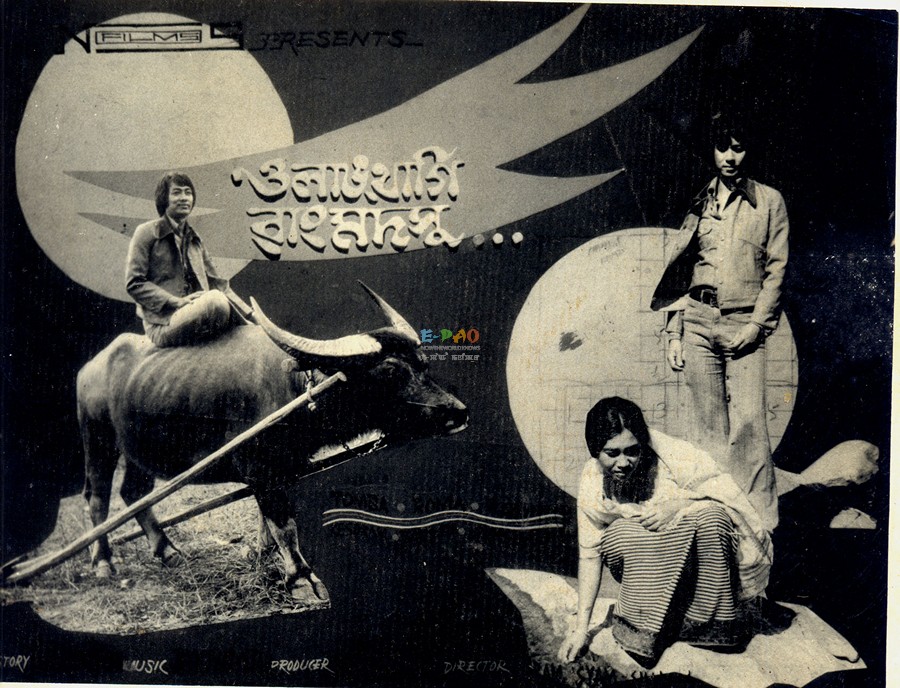Manipuriness
Manipuri Cinema, a world within a world Cinema
Bobby Wahengbam *

A film poster for Olangthagi Wangmadasu
'Manipuriness', 'the word' was suddenly thrown upon the film makers in Manipur around 2008. The word seems to be easy to understand. Everyone thinks it is known to them but in practice it happens to be the most difficult one in the process of film making. Things are discussed in various levels in numerous platforms. Participation in some of such forums are made mandatory if one intends to continue film making especially in feature film making as it is a genre of the masses. And everyone who is making films seemed to be confused.
Those who are passionate about their subjects would suggest things about being Manipuriness from their point of view. But it was difficult for the infant film industry to argue or follow each and every comment/suggestion made. As the life has to go, it has been managed somehow with the strengthening of Film Forum, Manipur.
'Manipuriness' lies not only in physical appearance but also in the nuances offilm art. How can one say a film is rich in Manipuriness with traditional dresses, costume, songs and language while the form, treatment and story content borrowed heavily from other sources?
Production of a Manipuri film is no more a difficult proposition. If one is ready to invest a meagre amount of Rupees 4/5 lakh, he can manage to produce a film. So the industry is inviting people from different walks of life. Old companies are living the trade but many new production houses are venturing for various other interests other than business and love of cinema.
Iconic figures in Manipuri Cinema
Mangol has been cognitively used in Manipuri cinema. In the absence of proper film shooting studio, mangol serves as a readymade location. But with the changing standard of life and modernization the cognition and connotation of the same has been transforming. In earlier films, a traditional Meitei house with a huge Mangol used to be cognitive for rich, influential and powerful people.
But now, with the advent of modern buildings and structures, the Mangol connotes for middle class family. And for the lower middle class, there is small mangol and hence an important location. The cognitive use of mangol for the upper and upper middle class has been shifted to the drawing room of a building.
This trend has started with cult films like 'Olangthagi Wangmadasu', 'Wangma Wangma' etc. In 'Olangthagi Wangmadasu' both the Mangol and the drawing/waiting room are exploited. In the 'Olangthagi Wangmadasu', the two locations speak more than just the economic status but echo the conflicting social status of the time. It was a period where buildings were just coming up and cars were rarely seen on the road. It was a modernization phase. The old traditional house represents old, strong, firm, traditionalbeingrepresented by the grandfather.
And the maker is worried of losing the valuable tradition. This is reflected well in the second layer. At the same time the maker sarcastically tease the memsahebs and the officers who are trying to ape the modern lifestyle. The Memsaheb, coming back from shopping, calls out the male servant.
Memsaheb - Bahadur, Paani Le ao!
The servant brings a bucket of water. The memsahib, not knowing Hindi well, tells him.
Memsaheb - ThanknanabaPaani
The audiences laugh aloud in unison.
Both the Mangol and the drawing room are used to define the economic status of the characters in modern blockbusters like 'Basantagi Nongalamdai', 'Mikithi' and scores of others. In absence of proper shooting studio in Manipur, actual locations are extensively used where the modern drawing room and the traditional Mangolsbeing the easily accessible locations. Mangols have also been location for song sequences. Today a romantic song is shot in a Mangol. Eg. Hailamhenbapakhang, kananahau enungsiba - picturised on Gokul and Balain the film 'Bema Bema'.
Another iconic figure in Manipuri cinema is the bed. It is the location for both the male and female protagonists to talk and discuss things with their close friends. Now, sports stadia have been destinations to denote modernity.
Manipuriness and Cinemaness
Cinema is now a common property of one and all. Though, it was invented in America, nobody ever claims that cinema is an exclusive property of the US. In the history of cinema, different countries contribute in their own way theoretically, aesthetically and technically making cinema the most wonderful medium. Contribution to cinema as a whole brings better popularity and respect to a community, group, country or individual than having NESS of the same.
To cite an example, 'The Russian Montage' of Eisenstein, Pudovkin and others remains a greater contributor to the Russian National Image and the world of Cinema than hundreds of other Stalin government sponsored Russian films that strived to propagate Russian Image and Russianness. Eisenstein successfully introduced a new approach in film language that combination of two unrelated visuals can bring another unrelated third meaning. A shot of a child's cry followed by an empty plate would denote that a child is crying in hunger. In this universal theory there is nothing Russian about but it is known as Russian Montage occupying a respectable place in the history of cinema bringing Russia in the forefront.
If we look at the German Expressionism of the 1920s, it is not for having Germaneness in those films that bring German an important name in film history but for the school of thought those films carry. The use of exaggerated set, costume, action, lighting and movement which was an extension of expressionist paintings (eg scream by Monet) style that made German a very important part of the film history. The conviction that film should be realistic is not applicable here. Films on Nazis by Nazis and other German centric films could not go closer to Expressionist films in show casting the Germaneness in the world of German films.
The film Noir or the cowboy films of Hollywood has its own distinctive place in world cinema no matter how unrealistic the films are. And it shows the other exaggerated and imagined side of America.
The most influential Italian Neorealist films do not speak vocally about Italian culture and Italian ness. But sure, it talked about the impact of the Second World War in Italian society and a new approach in film making.
The case is the same for the Nouvelle vogue or 'the French New Wave'. The new style of film making that even broke the prevailing grammar of film language with the introduction jump cuts (Godart) and other approaches changed film diction. The development even made people felt that the Cinema belonged to France.
With looking back to the past, it would be wrong to say that films should always be realistic. Unrealistic films such as Hong Kong Martial art films could make the Chinese familiar to the world. Some people claim such Hong Kong based Chinese Martial films as loud, artless and even stupid. But these films are highly entertaining and could hold the interest of the masses. This style remains a unique genre in the world cinema. Actor like Jackie Chan who is a product of such films becomes a face of all the mongoloids.
In the present so called globalised world, the confines of regionalism and country ness seem to be fading if we look from another angle. The highly 'Koreanese' films of Imkean teak is a passť now. The most successful Korean director who brings Korea in the map of world cinema is Kim KiDuk. Almost all of his films are termed as classics. But most of his films have his individual signature more than being Korean. His new universal approach has done wonders to the Korean film history.
The Fifth generation directors are considered to be the greatest contributors to Chinese film history where most of them were compelled to make films in exile. (Raise the red lantern, Yellow Earth etc)
To summing up things, 'cinemaness' is something one should not neglect in creating a body of art. Incorporating the rich tradition of arts and culture as well as the gift of nature, there is possibility to innovate a new film making approach which might come to be known as Manipuri Genre. And that will speak volumes of 'Manipuriness' without limitations.
